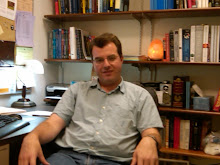I've finished chapters 3 and 4 of Hofstadter's "Academic Freedom in the Age of the College." A few things leap out at me:
First, US higher education was different from the rest of the world in one key respect from the very beginning: The colleges were subject to lay boards of governors or visitors (or trustees, or regents, or various other terms that modern institutions use), while European faculties were self-governing. This accountability to non-academic authorities, many of them "local notables", might explain some of the oddities of US higher ed, not the least of which is that our schools devote enormous resources to athletic teams that don't advance the academic mission, may or may not be net revenue contributors, but certainly entertain the locals.
Second, academic freedom in US colleges paralleled the rise of religious freedom, largely in response to two trends: The increasing religious diversity of the US and the increasing numbers of students pursuing non-clerical careers. As students moved away from clerical careers (especially in the years right before the Revolution) religious identity became less central to collegiate identity. Also, if you need tuition dollars in a diverse society you can't afford to limit your enrollment to one sect. Yes, there are a few religiously strict institutions in the US today, and today we would regard that as an oddity of US higher ed, but overall US higher education got on the religious tolerance bandwagon long before Europe.
(As an aside, today's distinctively denominational colleges should be understood not just as oddities in international terms, but also as oddities by American historical norms. As a proud product of Catholic grade school, a type of school that is proud of its distinctive religious identity, this gives me something to think about. I have written before that my academic mindset is influenced in part by the New England roots of American higher ed, yet my personal identity is very deeply influenced by the Catholic grade school that educated me in my youth. It is rather strange that the strength of American higher ed owes so much to its ecumenical history, yet I consider it a point of pride that I am a product of Catholic education.)
Interestingly, the shift away from solely emphasizing clerical training also led to the first science and math professors on US campuses, and the role of a "professor" was disturbingly similar to the current way we classify academic staff. Back then, most teaching was handled by low-status "tutors" or "instructors." The rest was done by the college President and perhaps one or two other Professors. The difference between the Professors and tutors was that the Professors were high-status experts who expected to be around for a while (though not with our modern concept of tenure), while tutors were biding their time until a better job opened up (usually in the clergy). The ratio of Professors to tutors was probably lower than the ratio of tenure-track faculty to non-tenure-track faculty today, but the trend is definitely in the direction of how things used to be. That doesn't mean we should be nonplussed by a regression to historical norms, but it does reinforce that the best way to understand the consequences of trends in the present is often to compare and contrast with the past. All of this has happened before and will happen again.
Anyway, some amount of math and science teaching was happening in colonial colleges before they had math and science Professors, but it wasn't until the late 1700's that math and science Professors were appointed in significant numbers. Interestingly, they were the first Professors outside of theology. Certainly history, literature, etc. were being taught, but nobody was appointed with the title of Professor of History (or whatever) at that time. What is amazing, both in comparison to Europe back then and America now, is that the math and science professors arrived in American colleges without incident. Oh, I'm sure that somebody or other in the faculty lounge was grumbling that the math professor was getting the office with the nice window, but there was (at least according to Hofstadter) nothing comparable to the Galileo Affair of 17th century Europe or the Scopes Monkey Trial of 20th century Tennessee. That is remarkable to me. Indeed, even a century before Professors of science were appointed, Hofstadter notes that Puritans were remarkably unperturbed by people reading the works of Galileo and Copernicus. Given that Protestants of the 17th century were at least as conservative in their scriptural interpretation as any of the Roman Catholic officials who went after Galileo, this is truly extraordinary. The American spirit of tolerance apparently has deep roots.
Now I have to dive back into a pile of grading and prep and committee work. Hopefully by the end of the week I'll have a chance to finish the last chapter of Hofstadter.
Subscribe to:
Post Comments (Atom)




No comments:
Post a Comment